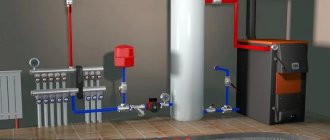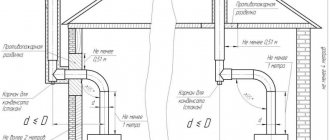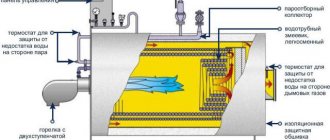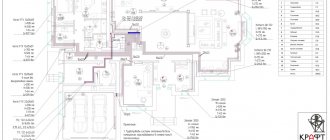If you are planning to begin installing a new heating system in a private home, then before you begin making calculations, as well as purchasing the necessary equipment and consumables, you need to find out what documents you will need to obtain allowing you to begin carrying out the planned work. Therefore, let us immediately note the main regulations governing the installation of an individual heating system:
- Resolution No. 307 “Procedure for connecting to the heat supply system”, which clearly describes the technical parameters of boilers that can be used for operation in heating systems of apartments or private houses.
- The Law “On Heat Supply”, the document contains applications regulating the installation of heating systems with restrictions and regulations.
How to arrange electric heating
Electric heating today is a serious alternative to gas heating.
The cost of gas depends on those from whom we buy it, and to some extent we can regulate the cost of electricity ourselves. Thus, in Europe, which also imports gas, this was understood a long time ago. Therefore, electric heating systems have their mass consumer. In Norway, the share of heat obtained from electricity is 80%; in France, about 40% of houses are equipped with electric heating systems; in Spain, more than 30%. Electric heating of premises is also becoming widespread in the USA and Canada. In these countries, electric heating systems are traditionally built on electric convectors. Heating systems based on electric convectors are characterized by simplicity, speed of installation and installation of heating devices, ease of operation, ease of control and automation of the process of heating rooms, no need to use coolant and atmospheric pollution products.
Installation of wall-mounted electric convectors "Termiya" due to low inertia, high accuracy of maintaining the temperature in the room, increased efficiency of converting electricity into heat allows you to save up to 10% of electricity compared to traditional heating systems using electric boilers.
Savings can be achieved by choosing an electric heating system that is subject to preferential tariffs for the population, and using these relatively inexpensive heating devices in the heating system.
Preferential tariffs for electric heating for the population
Considering that an electric boiler and a wall-mounted electric convector are stationary heating devices, with proper design of electric heating, you can, in accordance with current legislation, use a preferential tariff for electricity - 21.54 kopecks / kW • hour.
This tariff is valid from October 1 to April 30 for the amount of electricity consumed up to 3600 kWh per month. For comparison, when using a general tariff, if the use of electric heating devices is not formalized in the proper manner, the consumer must pay for the volume consumed over 800 kWh of electricity per month - 95.76 kopecks / kWh. Thus, with proper design, it is possible to save more than 4 times the cost of one kWh during the heating season.
A total volume of electricity of 3600 kWh per month is quite enough to heat an apartment or house with a total area of 100-120 m2 during the average heating season in Ukraine.
To take advantage of preferential tariffs and rates for electricity in the case of stationary electric heating, you must:
1) consumers living in rural areas, contact the village (settlement) council for information about the presence of an act on the absence of gasification in your locality. Residents of cities or regional centers must contact the regional branch of the State Inspectorate for Energy Supervision over the modes of consumption of electrical and thermal energy in the regional center, the cities of Kiev and Sevastopol (hereinafter referred to as the State Inspectorate) to obtain a certificate of the absence of gasification with natural gas and the absence or non-functioning of systems centralized heat supply in individual apartment buildings;
2) on the basis of the act, write an application to the Distribution Zone or another organization, for example, an interdistrict service area, authorized by the regional power company, with a request to give permission to connect a stationary electric heating installation to the electrical network of the energy supplier. The application must indicate the following information: the name of the object and its location, the applicant’s passport details.
The following are attached to the application:
a. receipt for payment of the cost of the permit or receipt of technical specifications; b. a questionnaire for the population signed by the customer, compiled according to a standard form, which indicates information about the parameters of the customer’s facility; V. a copy of the certificate of ownership of a document confirming the right of ownership or use of the object.
3) If the commissioning of an electric heating system at home does not lead to an increase in the power consumption of the entire architectural object (house), compared to that specified in the current contract for the supply of electricity between the consumer and the energy supplier (in a typical case, this power is 3-5 kW), then it is necessary, with the help of the Distribution Zone or a design organization, to develop a project for the re-equipment of intra-house networks and / or external power supply networks;
4) agree on a technical solution for the project with the Distribution Zone;
5) purchase the necessary equipment;
6) according to the project, agreed upon in the prescribed manner, reconstruction, re-equipment or construction of facilities is carried out, which is carried out by the Consumer independently, an organization or person authorized by the Distribution Zone;
7) conclude a new agreement or make changes to the agreement on the use of electrical energy, which must indicate the possibility of using specific types of electricity tariffs (in the case of installing a multi-zone meter - depending on the time of day and the date of the calendar year);
 in the case where the commissioning of an electric heating system at home leads to an increase in the power consumption of the entire facility (house) compared to that specified in the current contract for the supply of electrical energy, it is necessary to additionally obtain Technical Conditions from the Distribution Zone;
in the case where the commissioning of an electric heating system at home leads to an increase in the power consumption of the entire facility (house) compared to that specified in the current contract for the supply of electrical energy, it is necessary to additionally obtain Technical Conditions from the Distribution Zone;
9) further – steps according to paragraphs. 4 – 7;
10) if you want to replace the meter and/or switch to a multi-zone tariff, you must additionally purchase a new meter, parameterize the meter at the metering device operation center and contact the regional energy sales office to install and register the meter.
The next step in increasing the efficiency of an electric heating system is the use of multi-zone meters (cheap electricity consumption at night).
Installing multi-zone meters allows you to save without the use of special measures - up to 10% of funds with two-zone metering, up to 9.6% with three-zone metering. In addition, cost savings can be increased through additional special measures, such as: the use of special timers that increase the load on heating devices at night and, accordingly, reduce it during the day. At the same time, it is possible to ensure comfortable indoor conditions by accumulating heat from heating devices in the walls, ceilings and floors of the premises. The practice of using timers in combination with three-zone electricity meters proves that in this case you can save up to 20% of money.
So, we see that there are opportunities to save energy costs, you just need to use them correctly and skillfully.
Registration of electric heating – Tariff “Electric heating”
Previous legislation already provided benefits for certain types of electrical heating equipment when registering for autonomous electric heating. Namely – for electric boilers and heat pumps. The new order included other modern systems in the list, including:
- heated floors (read about how to calculate heated floors here);
- warm baseboards;
- ceramic panels (read about how to calculate warm baseboards and heating panels here);
- stationary convectors.
The only additional requirement was the mandatory approval of the project, which indicated the total capacity of the system. In this case, designing your own autonomous electric heating allowed you to pay for electricity up to 3000 kW throughout the entire heating season:
- 0.90 UAH/kW during the daytime;
- 0.45 UAH/kW at night, subject to registration and installation of a zone meter.
Thus, individual electric heating with parallel accounting of energy consumption using a “day/night” electric meter reduced costs not by 2, but by 3 times.
How to apply for a “preferential” tariff for houses without central heating and non-gas supply houses
In connection with the approaching heating season, the State Unitary Enterprise of the Republic of Kazakhstan "Krymenergo" clarifies information on the registration of a "preferential" tariff for houses without central heating and non-gasified houses.
1) If you live in a non-gas building with three or more apartments, in which there is no centralized heating supply or does not work
To apply the tariff* established for the population living in houses with three or more apartments, not gasified with natural gas and in which centralized heating systems are absent or not functioning, the subscriber must contact the management organization servicing the house with three or more apartments (municipal unitary enterprise, housing office etc.) with a request to draw up a certificate of absence of gasification with natural gas .
Next, the representative (the subscriber himself or a representative of the municipal unitary enterprise, housing office, etc.) applies to local government authorities for confirmation of the fact of the absence of gasification with natural gas and the absence (non-functioning) of centralized heat supply systems:
- An act on the absence of gasification with natural gas and the absence (non-functioning) of centralized heating systems in individual buildings with three or more apartments is issued by local governments in triplicate based on an application from the management organization;
- The act is drawn up in any form in three copies, one of which is provided to the State Unitary Enterprise of the Republic of Kazakhstan "Krymenergo", the second to the State Committee for Prices and Tariffs of the Republic of Crimea, the third remains with the local government body.
- The act must be signed by a commission chaired by the head of the local government body and certified in the prescribed manner.
The resulting Certificate is unlimited, but it must be confirmed annually and confirmed data must be submitted to the energy supplier every year.
- The owner of a building with three or more apartments (municipal unitary enterprise, housing office, etc.) at least once a year contacts the relevant local government body to obtain confirmation of the absence of natural gas supply and the absence (non-functioning) of centralized heating supply systems in individual apartment buildings with a corresponding certificate (signed by the head of the local government and stamped).
- The balance holder of a house with three or more apartments (municipal unitary enterprise, housing office, etc.) 20 days before the expiration of the tariff, provides the specified certificate to the State Unitary Enterprise of the Republic of Kazakhstan "Krymenergo", and also informs the State Committee for Prices and Tariffs of the Republic of Crimea, attaching a copy of the certificate.
It is important to know: the application of the specified tariff is possible only in the absence of gasification of all apartments of a residential building and the absence (non-functioning) of a centralized heating supply system in the building as a whole .
* clause 1.6 of Appendix No. 2 to the Order of the State Committee on Prices and Tariffs of the Republic of Crimea “On the establishment of tariffs for electrical energy for the population and consumers equated to the category “population” in the Republic of Crimea” dated December 21, 2016 No. 53/1 .
2) If you live in a residential building equipped with electrical equipment (electric stove, electric heater, electric heating)
To apply the tariff* established for the population living in residential buildings equipped with electric heating units and/or electric stoves, the owner (user) of a residential building (including a hotel-type residential building or dormitory) must provide the residence:
1. An extract from the Unified State Register of Rights, which indicates that the purpose of the house is “residential”**;
2. Technical passport*** containing information about equipping the house with electrical equipment (electric stove, electric heater, electric heating installation.
The presence or absence of a gas pipeline and/or centralized heating does not matter for the application of the preferential tariff!
Based on the consumer’s application and the electrical installation inspection report indicating all installed electrical equipment, the energy supply contract with the household consumer is re-concluded (if necessary), and in the database of the State Unitary Enterprise of the Republic of Kazakhstan “Krymenergo”, from the date of re-conclusion of the contract, the corresponding tariff is established on the consumer’s personal account.
* clause 1.5 of Appendix No. 2 to the Order of the State Committee on Prices and Tariffs of the Republic of Crimea “On the establishment of electricity tariffs for the population and consumers equated to the category “population” in the Republic of Crimea” dated December 21, 2016 No. 53/1 . In this case, the tariff “for electric heating” is applied in the presence of two factors simultaneously: a) the house must have a residential purpose, b) the house is equipped with an electric stove and/or electric heating installation in the manner prescribed by law ( clause 71 of the “Fundamentals of Pricing in the Area of Regulated Prices ( tariffs) in the electric power industry”, approved by Decree of the Government of the Russian Federation dated December 29, 2011 No. 1178)
** In accordance with clause 6 of Article 12 of the Federal Law “On state registration of rights to real estate and transactions with it”, information about the characteristics of the building, including its purpose (residential or non-residential), is contained in the Unified State Register of Rights to real estate and transactions with it, and are provided in the form of an extract.
*** According to clause 5 p. 19 of the Housing Code of the Russian Federation, a document containing technical and other information about residential premises related to ensuring their compliance with established requirements is the technical passport of the residential premises. A technical passport can be obtained from the Bureau of Technical Inventory (BTI).
Coolant
The use of high-quality coolant is the key to the normal functioning of engineering and climate control systems in public, residential and industrial facilities. Today there are a large number of working compositions for heating systems and climate control equipment on the market, but not all can be called reliable and effective. It is important not to prioritize the economic factor, but to select antifreeze based on the operating conditions of the equipment. A simple example: if relatively affordable boiler water is used in a heating system with a high risk of freezing, expensive equipment may become completely unusable. The costs of repairs and replacement of the used composition with a suitable coolant will be much higher. With such a variety of options, a logical question arises: where can you buy high-quality coolant in bulk? What performance characteristics of the mixture should you pay priority attention to and how to choose a trusted supplier?
Electric heating in a private house, what documents?
Changes to the agreement can be completed at any DTEK Kiev Electric Grids based on:
1. project documentation confirming that the apartment/private house is equipped with electric heating installations. 2. document confirming the commissioning of the electric heating installation:
a) technical passport of the facility with information on the commissioning of the electric heating installation;
OR
b) the original and a copy of the design documentation for the installation of internal electrical equipment systems, containing information about the equipment of the applicant’s facility with electric heating installations and a declaration of readiness of the facility for operation registered with the state architectural and construction control authorities.
Acceptance
After all this work was completed, I called a geophysical laboratory to measure the grounding, wiring and circuit breakers. I paid about 80 rubles.
When I received the laboratory’s conclusion, I submitted an application for acceptance by energy supervision. The first one is free, but they say that you don’t have to pay for the subsequent ones either.
About a week later (I chose the date myself) I brought the inspector to the house. He examined everything carefully and, to my great surprise, said that it was not interesting to be with me, because there was nothing to complain about.
All that's left to do is wait for the acceptance certificate and connect everything to the power line. The act was ready in about 2 weeks. I immediately wrote an application to disconnect the old input to the house and connect two inputs: for heating and a new input to the house. I paid 156 rubles for this. On the appointed day, the team arrived and completed all the work in an hour, and also double-checked the correct assembly of the shields.
Shield for the house
Briefly about the main thing
Household electric boilers are divided into 3 types - classic, electrode and induction. Most often, classic ones are used, powered by heating elements. Among their advantages are high efficiency, easy installation, safety, environmental friendliness, compactness, light weight and diversity of the model range. Disadvantages include high power consumption and the need for grounding.
For proper installation of an electric boiler, it is necessary to take into account a number of safety rules and electrical installation requirements. To operate the heating unit, the following piping elements are required:
- Circulation pump.
- Expansion tank.
- Safety valve.
- Automatic air vent.
- Pressure gauge.
Equipment is distributed in the circuit strictly in a certain sequence. Installation of an electric heating boiler in a private house is carried out in 6 main stages - design and calculation, site preparation, installation, network connection, installation of electrical protection and startup.











